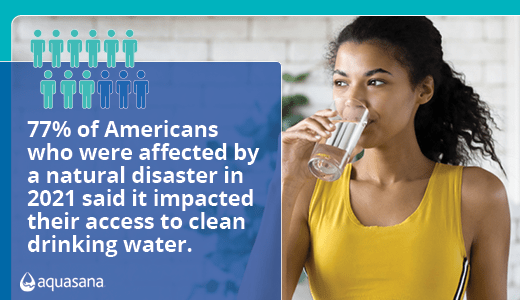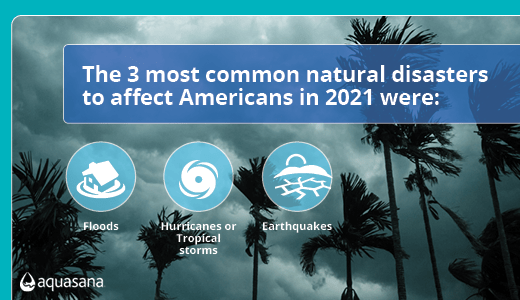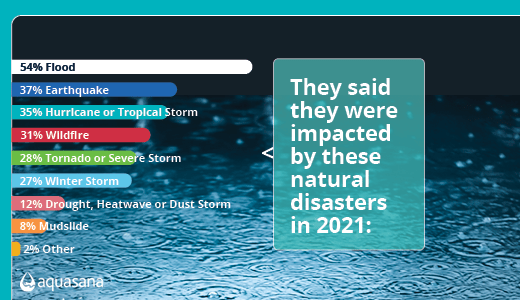How natural disasters impacted people by region
While natural disasters can have far-reaching effects, some places are more likely to experience one than others and people in these areas tend to be more worried about these events.
Specifically, we found that people in the South and West were most likely to report they were affected by a natural disaster in 2021, with 32% of people in each region saying they were impacted. This also lines up with survey data from the Pew Research Center — which found that people in the South and West were more likely to have noted experiencing extreme weather conditions in 2021:
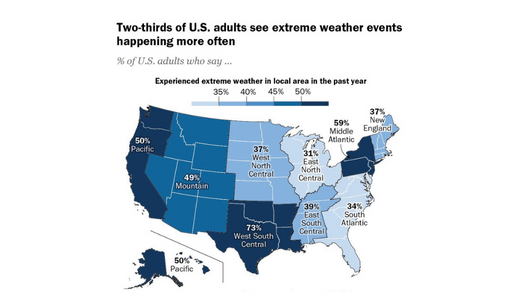
Image Source: Pew Research Center
Looking back at 2021 and natural disasters that occurred in the South and West, the major events weren’t random floods, hurricanes, or earthquakes — they were directly related to temperature changes on contrasting ends of the thermometer.
In the West, extreme heat provided favorable conditions for a historic wildfire season that started earlier and ended later than usual. Most notable of the fires throughout the year was The Dixie Fire — which ignited in July and lasted until the end of October. During that time, it engulfed over 960,000 acres throughout California, marking the second-largest wildfire in the state’s history.
Meanwhile, the South faced a different type of climate crisis — a frenzied freeze that saw temperatures go 40 degrees Fahrenheit below normal from Nebraska to Texas starting on Valentine's Day. As if the snow, sleet, and freezing rain weren’t bad enough for a region not accustomed to the cold — these conditions also resulted in power outages, broken pipes, and loss of heat that caused $24 billion in damages and 226 deaths. Winter Storm Uri or “Snowmageddon” as some people called it, has been called the worst winter storm in nearly 100 years and its impact won’t soon be forgotten. In our survey, people in the South were 50% more likely to say they were affected by a winter storm in 2021 than those in other parts of the country (15% vs. 10%).
How natural disasters affect drinking water
Now that you have context into how natural disasters are impacting people, let’s look at how different types of natural disasters can affect our access to clean water. Take a look at each natural disaster listed below to see what kind of impact it can have on water supplies.
Mudslides
Mudslides involve a surge of slush of mud, rock, and sediment known as “debris flow” that travels at fast speeds while damaging roads, infrastructure, and water supplies. Mudslides can be caused by many things, but the usual cause is heavy downpours in hilly areas that create runoff. As debris accumulates over time, gravity can cause structures holding it all in to collapse which results in the mudslide. Alternatively, mudslides can sometimes follow other natural disasters like volcanic activity, earthquakes, and wildfires which create ideal conditions for a mudslide to occur.
Beyond the damage mudslides can do to infrastructure that’s essential for access to clean water, they can also pollute freshwater systems. Mudslides have trouble crossing rivers, so usually when they come in contact with a river their contents simply flow in and pollute the body of water. Large deposits of silt and heavy metals increase the river’s turbidity and decimate the water quality. Water treatment plants may receive more debris than they can take out which can limit access to clean water.
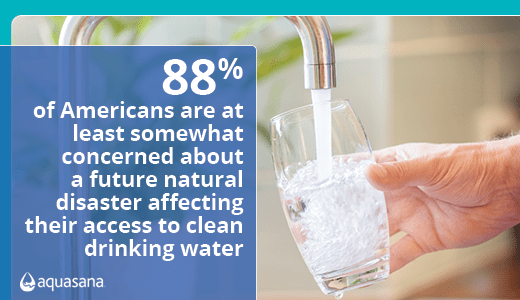
Floods
Floods were the most common type of natural disaster people were affected by in 2021 according to our survey, and they can have devastating impacts on water supplies.
A flood is an event that occurs when a large volume of water flows over areas that are normally dry land. Similar to mudslides, floods are likely to occur after a period of heavy downpour but can also happen during a hurricane because of the excess rainfall. As water flows through homes, businesses, farmland, and infrastructure — it can collect soil, waste, salt, pesticides, oil, and other impurities that contaminate water supplies. Floodwater can be dangerous to anything it comes in direct contact with, including private wells and public water distribution systems. In either case, the water may be unsafe to drink until runoff has been stopped and the contaminated water has been treated.
Hurricanes
Hurricanes may occur under specific conditions, which typically include warm water, moist warm air, and light upper-level winds. When these conditions occur, moist air from the ocean’s surface rises quickly collides with pockets of cool air — which creates growing clouds and thunderstorms that begin rotating due to the Coriolis Effect. The result is a devastating cyclone of water and wind that picks up pollutants from the ocean, air, and land it travels through.
Hurricanes on their own cause physical destruction that can damage water systems, including treatment facilities and infrastructure like pipes that transport water. Additionally, the heavy rain that accompanies hurricanes can cause the flooding issues discussed earlier.
Wildfires
Wildfires are uncontrolled fires that can be caused by natural conditions, like extreme heat and drought, but are usually the result of human actions like unattended campfires, burning of debris, and negligently discarded cigarettes.
Wildfires can negatively affect access to clean water in a few ways. During the fire, contaminants settle on streams through ash, and vegetation that holds soil in place burns away which can result in mudslides and floods. Additionally, the heat from the fire can burn plastic pipes used for water infrastructure and release volatile organic compounds (VOCs) into the supply, which occurred following a 2018 wildfire in California.
Volcanoes
Volcanic eruptions are caused by molten rock or magma, which is less dense than the surrounding cool rock above it. The lower density makes the magma rise, but on its way to the surface, gasses dissolve which creates bubbles that exert high pressure on the rocks above. That intense pressure causes the magma to break forth to the surface, which results in a volcanic eruption.
Lava can destroy homes and communities it comes in direct contact with, but the smoke and ash it releases can also impact air and water for distances beyond the initial area of impact. Just like with wildfires, ash settles into water and brings contaminants that can make it unsafe to use. Most of the time, volcanic ash turbidity will clear in a matter of days, but it can still create water shortages in the immediate aftermath of the eruption.
What to do if a natural disaster affects your access to clean water
If a natural disaster affects your access to clean water, start by tapping into an emergency water supply if you have one. Even if water flows through the tap, do not assume it is safe to drink unless you’ve been told so by local government officials. Recall that in some cases a natural disaster can cause water treatment facilities to be overrun with contaminants allowing impurities to bypass the measures set in place to ensure water quality.
If you have no water supply and your tap water is contaminated, you have two options:
1. Boil Your Water
For thousands of years, people have turned to boiling water as a method of purification, but how effective is it?
Water boils at 212 degrees Fahrenheit, and most microorganisms cannot survive in water that’s heated above 160 degrees Fahrenheit for 30 minutes. While boiling water will kill most microorganisms, it does not kill all bacteria and it won’t remove chemicals or solid contaminants like sediment and metals. In fact, boiling water actually concentrates the presence of metals making it more dangerous to drink. Beyond the safety drawbacks, it’s also time-consuming, as you’ll need to wait for the water to boil, then cool to an appropriate temperature. Boiling water should be considered a last resort.
2. Filter Your Water
Filtering water involves the use of a water filtration system to remove contaminants. There are several types of water filters including whole house, under sink, countertop, shower, and bottle filters.
Filtering water is a much faster and usually more effective option than boiling as long as you use a quality system (look for one certified by a third-party testing organization like NSF). After a natural disaster, you may have no idea what type of contaminants are in your water. Because of this, your best option is to use a system that offers maximum protection to tackle a wide range of contaminants, like a reverse osmosis or whole house system with a UV filter to eliminate viruses and bacteria. If you are specifically put on a “boil notice” by your city or municipality, then your filtration system will need to include a UV process in order to be made suitable for drinking. Of course, these systems are only relevant if you’re planning on staying at home following the disaster. If you plan to travel, make sure to pack a bottle with a filter which is less effective by comparison, but still an extra step towards safer water while you’re on the move.
How to prepare an emergency water supply
Every home should have an emergency water supply as a precaution. Even if you’re not worried about a natural disaster, other situations can result in unsafe drinking water conditions. For example, in February 2022 the city of Austin, TX experienced a rise in turbidity that clogged treatment systems and spilled into the city’s water supply resulting in a boil notice and low water pressure for around a week. It’s better to have a supply of clean water and not need it, than to need it and not have it during an emergency.
To ensure you have access to clean water in the case of an emergency, follow these tips for creating and storing a water supply.
1. Bottled or filtered water?
Storing unopened bottled water is probably the easiest way to create an emergency water supply, but that doesn’t necessarily mean it’s the best option. Preparing the right amount of bottled water could mean spending a lot, and the bottled water you purchase may actually be less safe than you think. Furthermore, over time trace amounts of microplastics from the bottles can leach into the water resulting in contamination. Filtered water is a better alternative if you can because you’ll spend less on tap water and can store it in food-grade plastic or glass containers that won’t cause contamination over time.
2. Prepare the right amount
The CDC recommends storing at least one gallon of water per person per day for three days for an emergency water supply. If you have extra space and money to spend, they recommend storing a two-week supply as an added safety measure. Of course, you’ll need to consider your situation following a natural disaster and ration appropriately depending on how long you think you’ll be without access to clean water. If your home contains hot climates, pregnant women, or sick individuals — consider storing extra water.
Store your water correctly
If storing filtered water, make sure to use a food-grade water storage container that will not transfer toxic substances into the water it’s holding. This means the container should have a lid that can be sealed tightly and made from a durable material. If you can, choose a container that has a narrow neck or opening so water can be poured out.
Before adding water to the container, you’ll need to sanitize it by following these steps from the CDC:
- Wash the entire container with water.
- Sanitize the container with a solution made from one teaspoon of unscented liquid household bleach and one quart of water. Make sure the bleach contains 5-9% sodium hypochlorite.
- Seal the container and shake well to ensure the solution touches all inside surfaces.
- Wait 30 seconds or longer before pouring the solution out of the container.
- Let the empty container air dry, or rinse it with filtered water.
- Pour clean water in and seal the container.
To ensure the water remains safe to drink, keep it in a secure location that’s away from direct sunlight and between 50-70 degrees Fahrenheit. You should plan to replace non-store-bought water every six months.
Key Takeaways About Natural Disasters and Access to Clean Drinking Water
Overall, our survey and background research revealed a lot about how natural disasters impact people and access to clean water.
We discovered that natural disasters are increasing in frequency and scale, and learned about the types of disasters that impacted Americans in 2021. We also learned that a natural disaster almost always impacts access to clean water, though the way it does so varies by the type of disaster. With this understanding, we also shared tips to help you prepare an emergency water supply for your home in case a natural disaster affects you.
For more information about our survey, check out our methodology and definitions as listed below.
Survey Methodology and Definitions
The findings presented in this article are the result of a March 2022 study of 2,246 U.S. adults, conducted by Aquasana. (Confidence Level: 95%, Margin of Error: 2%)
Demographic Definitions
Age Cohorts (based on Pew Research)
- Baby Boomers: 1946-64
- Gen X: 1965-80
- Millennials: 1981-96
- Gen Z: 1997-2012
Regions (based on U.S. Census map)
- Northeast: Maine, Massachusetts, New Hampshire, New Jersey, New York, Pennsylvania, Rhode Island, Vermont, Connecticut
- Midwest: Illinois, Indiana, Iowa, Kansas, Michigan, Minnesota, Missouri, Nebraska, North Dakota, Ohio, South Dakota, Wisconsin
- South: Alabama, Georgia, Kentucky, Louisiana, Maryland, Mississippi, North Carolina, Oklahoma, South Carolina, Arkansas, Tennessee, Texas, Virginia, West Virginia, Delaware, Florida
- West: Idaho, Alaska, Montana, Nevada, Arizona, New Mexico, Oregon, Utah, Washington, Wyoming, California, Colorado, Hawaii
Urban, Suburban, and Rural classifications were self-reported.
